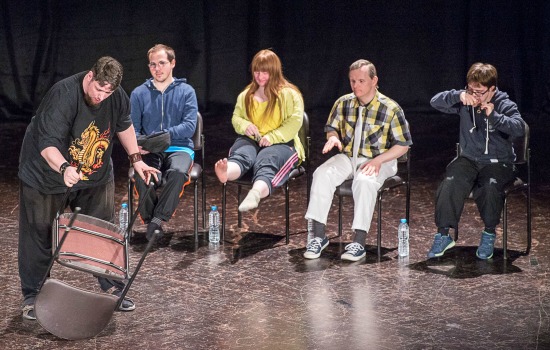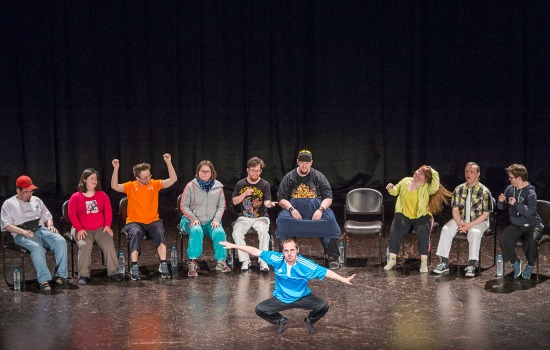Since its fourth edition in 2015, the Downtown Contemporary Arts Festival (D-CAF) has introduced shows highlighting disability into its vast programming.
In this context, the festival already included events such as Italy’s Mission Roosevelt (2015), which involved the participation of the public on wheelchairs; Austria’s Madeeh (2016), which worked on movement, dance and explored physicality with a few dancers on the wheelchairs; and Gaze (2016) by the UK’s Stopgap Dance Company, which employed disabled and non-disabled actors; among other shows.
Now, for the third consecutive year, the Arts and Disability segment of D-CAF in its sixth edition aims to challenge perceptions of the disabled by including people with disabilities and showcasing international artistic practices with the disabled.
This year the festival included a Swiss play entitled Disabled Theatre, staged on 21 and 22 March at AUC’s Ewart Memorial hall. The performance brought together ten actors from HORA Theatre, a Zurich-based troupe which since 1993 has used art and theatre to support and promote “the creative and artistic development of people with learning disabilities”, according to the programme notes.

Disabled Theatre (Photo: Bassam Al Zoghby)
HORA Theatre raises the public’s awareness of mental disabilities, and provides people suffering from disabilities with a platform for self-realisation and creative expression. In addition to the performance, a workshop entitled “Into the Wild” was held between 15 and 19 March by the members of the HORA theatre.
Created by choreographer Jerome Bel, the 90-minute-long Disabled Theatre begins with the actors – aged 24-46, and seated on the stage – presenting themselves one by one, providing name, age and profession, which is “actor” for all of them.
Then, again taking centre stage individually, the actors begin to describe their disability in a few sentences. Some mention aspects such as hyperactivity, communication frustration, problems with attention, memorisation or learning deficiencies, compulsive and/or obsessive behavioural traits, while others reveal how the community, be it the closest family or a larger social circle responds to their disability, and how at times they feel emotionally alienated or misunderstood.
We soon discover that the various behavioural and social aspects surrounding their lives being depicted are but different components of the same condition: Trisomy 21, a genetic disorder popularly known as Down’s syndrome.

Disabled Theatre (Photo: Bassam Al Zoghby)
This lengthy yet remarkable introduction allowed the audience to get closer to the world of the actors and others faced with the challenge of disability. The second part of the performance gave voice to their creative expression, walking the viewers through the individual dance routines that each actor or actress choreographed and chose the music for.
The audience was taken on a captivating journey through well-known disco and pop songs from the Swiss and international repertoire, from Michael Jackson to Justin Bieber through instrumental hits. The actors fused their professionalism with passion and energy, making the audience reflect on values much deeper than just a performance tailored to a mentally disabled cast.
As the HORA theatre’s website reveals, Bel’s work is known to stand beyond sheer theatrical and dance representation. It also challenges the perception of “disability that constitutes the limit against which the category of normality runs up”.
The highly successful, world-touring performance questions our own perception of people with mental disability and puts our understanding of what we coin “normal” to test. It doesn’t take long for the viewer to realise that when we categorise people through the prism of what we see as “normal” we are placing a limitation on our own minds.
On the artistic level, the performance invites us to revisit the rules which we set for theatre, dance or art in general, and look into our pre-defined expectations, since they too, become walls with which we surround ourselves and which choke our perception of life, people and creativity.

Disabled Theatre (Photo: Bassam Al Zoghby)
We can see how the HORA theatre actors are not forced to fit into a model that is preconceived so the participants look good in a pre-defined theatrical setting; the show is built around them and their abilities. It is their abilities that shine with striking honesty, spontaneity, artistic openness, as well as obvious professionalism. They all communicate beauty, and powerful human and creative ability, expressed through an artistic freedom.
And as the performance teaches us to look differently at disability, we question ourselves and revise the different angles of abilities that we often overlook or fail to understand. If in the social and medical parameters, most of us are considered fully-abled people, how come we are often unable to look into or embrace difference? And, in this context, who is it that is disabled?
The performance definitely pushes us out of our comfort zones and raises numerous burning questions which, even if HORA Theatre suggests answers to them, remain open for thousands if not millions of people across the world.
In Egypt, where the misconceptions surrounding the differently abled are a major problem yet to be addressed, the performance provided by the Swiss troupe is an important eye opener. It needs to step out of the American University in Cairo’s walls and reach out.
Last year, launching a crowd-funding campaign for an international troupe that works with dancers who have physical disabilities, the festival explained, “Around 10 percent of Egyptians have a disability; one third of them are children, and many have no access to rehabilitation services and suffer from misconceptions of their conditions in our society. Egypt was rated one of the six most intolerant countries worldwide for disabilities in 2015.”
The numbers are as shocking as they are saddening. They should trigger the artistic players as well as associations working with the differently abled to take action.

Disabled Theatre (Photo: Bassam Al Zoghby)
Ahmed El-Attar, the festival’s artistic director, explains that his long experience in theatre does not include working with the differently abled. He came across HORA three years ago when they performed in Theatertreffen, a large German-speaking theatre festival held annually in Berlin.
“I was impressed by the Swiss show that back then was called simply ‘Disabled’, on two levels. Artistically, I found it to be a very pertinent reflection on contemporary dance. On the human level, it was a very strong message,” El-Attar explains, commending the actors for their professionalism and strong presence on stage. Determined to bring the show to Egypt, El-Attar started exploring creative routes to embracing disabilities, something that has been obvious for three editions of D-CAF.
The HORA Theatre remained on El-Attar’s mind, yet he needed time to make their arrival possible. “For the funders, bringing over this play looked like a big challenge, a responsibility they probably feared. Equally, the actors’ families had their share of worries regarding the long journey, security and all that,” El-Attar explains. While visiting Zurich last year, El-Attar was invited to attend a whole day of HORA Theatre’s rehearsals.
“The day concluded with a meeting attended by the art managers as well as the parents of the actors. The parents expressed their opinions, but the actors also had their share of thoughts and spoke about their interest to perform in Egypt. The discussion in itself was a great experience.”
In his exploration of the arts and disability, El-Attar began understanding that here was a different category of performer: “They are not better or worse, they are just different and we must embrace that. I was happy that we could finally bring over this show. I also hope that this performance will make institutions working with the differently abled look at those people as impressive members of the society and not through the filter of pity. Look what art can do and how it benefits the actors! We also see an audience that is very receptive, yet people in general are always receptive,” he cncludes.
This article was first published in Al Ahram Weekly
For more arts and culture news and updates, follow Ahram Online Arts and Culture on Twitter at @AhramOnlineArts and on Facebook at Ahram Online: Arts & Culture
Short link: